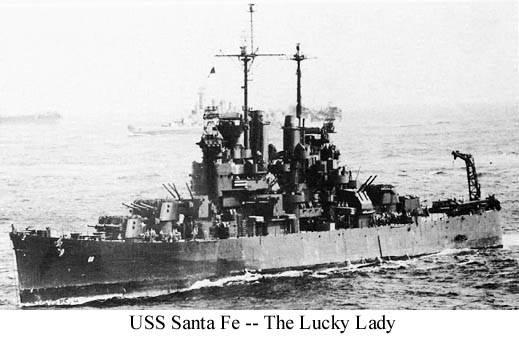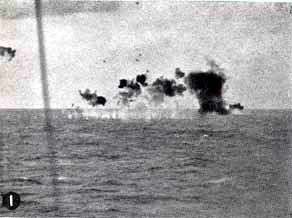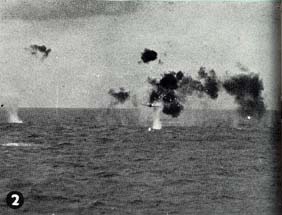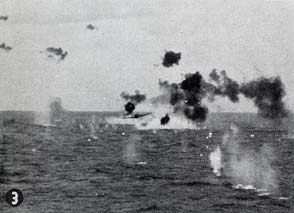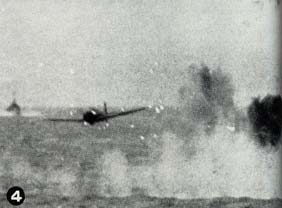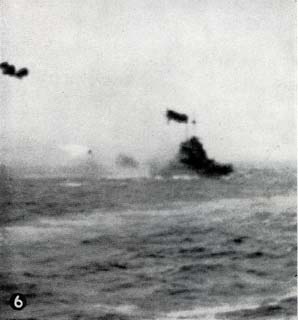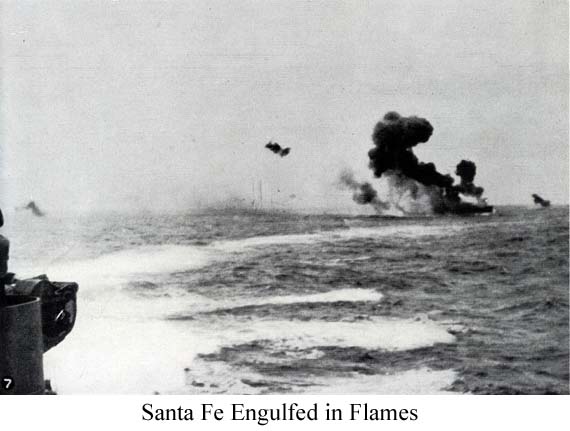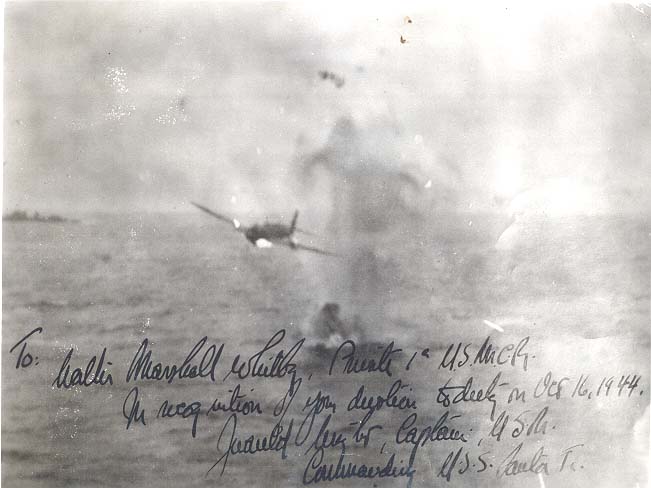|
After training with the Surface Striking Force near Eniwetok (30 August through 3 September), the SANTA FE rejoined her carrier group as it shoved off for the Palaus. From, 6-8 September the planes of Task Group 38.3 bombed and strafed the Palau Group, Peleliu Island being the primary target. On the evening of the 8th, the task force moved west to raid enemy airfields on the big Philippine island of Mindanao. Mindanao began absorbing punishment early on the morning of 9 September. As the second wave of Navy planes was returning home, they spotted a convoy of small enemy ships off Mindanao's east coast. Cruisers SANTA FE and BIRMINGHAM, along with Destroyer Division 110 were sent to attack the convoy, which they contacted north of Sanco Point about 1130. Fleeing Japanese ships were scattered about the seascape from Sanco Point to Mahaba Island, five of them afire as a result of the brush with U.S. Navy planes. Back and forth across the mouth of Bislig Bay the cruisers and destroyers paraded, taking the ships under fire as directed by Admiral DuBose, and as opportunity offered. Gunfire from the SANTA FE was concentrated on no less that 15 different craft, singly or in groups. Of these, four small cargo carriers were sunk, three left burning, and several badly damaged. Survivors claimed they had been six months enroute from the Japanese home islands, darting from port to port, afraid to venture into open sea because of American Naval air and surface power. At. 1345 the "cease fire" order was transmitted and the force left Bislig Bay to rejoin Task Troup 38.3. On 10 September Mindanao took her last pounding, and next day the task group headed eastward to fuel.
Carrier air blows fell in the Visayan Sea area on the 12th, 13th and 14th of September. On the 13th the SANTA FE fired at a lone enemy plane which dropped a bomb near carrier LANGLEY. On the 14th the cruiser's two seaplanes teamed to rescue two downed aviators. Task Group 38.3 then went to the support of U.S. Marines who plunged ashore on much-bombed Peleliu 15 September 1944. Although the battle in hillside caves and mangrove swamps was a stiff, slow one, the all-out offensive was underway to "gain and maintain the eastern approaches to the Philippines -- Formosa -- China Coast area." When it became evident that no aerial support was required at Pepeliu, Admiral Halsey sent his carriers dashing to the Philippines once more. Manila, Pearl of the Orient, felt the crushing power of the U.S. Navy's air arm for the first time on 21 September. There was another strike on the 22nd and another tussle with enemy planes for the SANTA FE before Task Group 38.3 turned to the southeast for a quick fueling. Setting up shop off San Bernadino Strait on 24 September, the carriers launched continuous strikes on the Central Philippines.. That evening they again refired eastward, anchoring in Palau's Kossol Passage on 27 September 1944. The possibility of an air and surface attack emanating from Japanese-held Babelthuap Island, five miles away, forced the ships to abandon the Kossol anchorage nightly and return at daylight. On the 1st of October, Task Group 38.3's constituents hove their anchors and moved to Ulithi Lagoon in the western Carolines. For the next six months, this lonesome anchorage of palm-dotted islands was to be USS SANTA FE's base of operations. As a preliminary to American reentry into the Philippine Islands, Halsey's highly successful strikes of September were resumed, this time farther north. Sortieing from Ulithi on 6 October 1944, the SANTA FE went northwest to the Ryukyes with Carrier Task Group 38.3. Submarines and long range aircraft ran interference, destroying enemy search planes and picket boats so that they heavy forces achieved tactical surprise when they arrived south of Okinawa 10 October and went to work. After a day of hitting Okinawa airfields and shipping facilities the planes were retrieved, and the surface units retired southward for fuel. Taking advantage of the lull on the 11th the Japanese rushed reinforcements on a lavish scale to the threatened area, and prepared to expend their maximum available air strength to expel Task Force 38 from the Empire's inner zone of defense. Installations on Formosa and the Pescadores were hit 12 October, and at 1835, as the marauding U. S. fleet began pulling out of the strike area, it got its first taste of the violent Japanese reaction. Japanese planes fiercely assailed the retiring flat-tops, with task groups adjacent to "38.3" bearing the brunt of the coordinated attacks. Formosa was hit again on 13 October, and again the Imperial Air Force lashed out in full fury when the task force withdrew at nightfall. Combined gunfire from the SANTA FE and her cohorts turned back their aerial opponents, but at 1835 the heavy cruiser CANBERRA, in Task Group 38.1 to the south, reported that a torpedo had exploded in her side. Rear Admiral DuBose hurried to the scene to direct salvage operations and, while the cruisers of his division circled the listing CANBERRA, the WICHITA took her in tow and chugged eastward at 3 knots. The tempo of retaliation rose sharply on 14 October. Not until 1839 did any of the planes get through to the SANTA FE. Captain Wright's guns sent one bomber scurrying, and shot down another in flames at 1917. Making stack smoke, the SANTA FE cruised at high speed around the tow until attacks ceased for the night at 2340. Meanwhile the light cruiser HOUSTON, who had taken CANBERRA's place in her task group, caught an aerial torpedo close to the keel, deep amidships. Powerless and within a few trembling bulkheads of sinking, the HOUSTON became an added burden to the CANBERRA's protective escort on the morning of the 15th. Fighters from the carrier CABOT intercepted several large Japanese formations which threatened the retiring cripples throughout 15 October. During the day the SANTA Fill fed oil to numerous fuel-hungry destroyers which came alongside and rigged huge hoses. Funeral services for her 23 dead were in progress aboard the HOUSTON shortly before noon on 16 October, when General Quarters was sounded. Shipping, the sea in a welter of white water, the other cruisers and destroyers hurriedly formed an air defense disposition as ninety torpedo-toting Japanese planes came snarling in, hot on the oil-slick trail left by the two damaged ships. Fifty of the attacking aircraft were downed by pilots from CABOT and COWPENS; and others were turned back to their shore bases. Only three broke through. Before it was felled by anti-aircraft fire, one of them drove home a torpedo in the HOUSTON at 1345. The impact blew the hanger hatch 150 feet into the air, swept.20 men off gun mounts into the sea, and set gasoline ablaze on her stern. Four minutes later a single-engine torpedo bomber slipped in to sand-bag the SANTA FE, and dropped a tin fish which exploded in the cruiser's frothy wake. SANTA FE gunners sent shells into the fleeting fuselage and the Japapese plane smacked into the sea close aboard the bow. A shower of flaming gasoline and plane parts cascaded over those manning 20mm gun tubs on the bow, killing one Marine, and wounding six Marines and one sailor. Other raiders attempted to close but were dispersed by the omnipresent combat air patrol. Flagship SANTA FE, having suffered her first war casualties, was detached with her sisters on 17 October. Badgered Cruiser Division 13 rejoined Task Group 38.3 the next morning.
"Sho No. 1," the Japanese plan for defense of the Philippines, was about to be put to the test. At 0800 on 17 October 1944, an advance party of Rangers began planting themselves on islets in the mouth of Leyte Gulf. USS SANTA FE covered Task Group 38.3 about 300 miles east of Luzon while the battle for Leyte Island was being waged. On the 20th of October her force swept in on the Philippines and launched two strikes over the Visayan area, returning eastward that night. |

